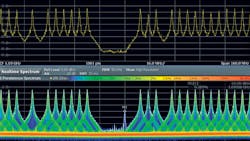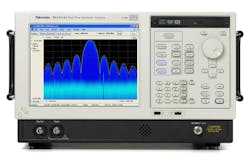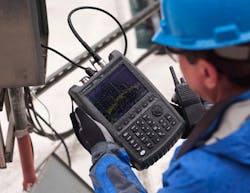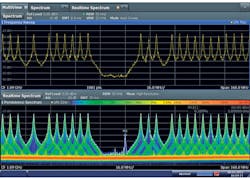From Real Time to Real Accuracy: Spectrum Analyzers Have Your Signal Covered
Spectrum and signal analysis provide the test and measurement foundations for RF/microwave applications ranging from simple component test to advanced pulsed-radar techniques (Fig. 1). Spectrum analysis began in the mid-1900s with moderately performing frequency-selective voltmeters. Now, modern analyzers can measure the amplitude, phase, modulation, and even time-domain information in everything from racks inside specialized test labs to handhelds in external harsh environments.
This file type includes high resolution graphics and schematics when applicable.
There are many deployment formats as well as types of spectrum-analysis techniques (Fig. 2). The three basic types of spectrum analyzers that can measure radiated spectral information include the swept-tuned spectrum analyzer (SA), vector signal analyzer (VSA)—or fast Fourier transform (FFT) analyzer—and real-time spectrum analyzer (RTSA). The techniques and methods used by each type of analyzer vary, as do their capabilities.
Spectrum Analyzers
The original SAs used a swept-tuned superheterodyne architecture that measured signal power versus frequency, and that same method is used today. This capability is enabled by the downconversion of a received signal using a highly linear and low-noise mixer.
The received signal is picked up by sweeping a very narrowband resolution filter along the analyzer’s frequency-sweep range. Next, an RF/microwave power detector is used to capture the amplitude at each sequential frequency stage in which the filter is swept. The amplitude data points are then stored in memory for collection and analysis. Each amplitude data point is mapped to the displayed frequency range on the analyzer’s visual interface.
Today’s swept-tuned SAs are very capable of providing high-dynamic-range measurements with good phase noise and low-distortion products. “The lower-speed ADCs (analog-to-digital converters) of a swept-tuned analyzer perform a cleaner acquisition,” says Eric Brown, signal analyzer strategic planner for Agilent Technologies (www.agilent.com).
The problem with this approach is that signals that vary faster than the sweep could be inaccurately represented or completely missed in the acquisition. With swept-tuned SAs, there also is no reliable way to discover if the signals are being misrepresented or lost. Modern commercial and tactical applications often employ impulse and rapid changing signals with digital modulation for communications and radar. More detailed information on the quality of those transmissions may be desired, which has led to the development of vector spectral measurements or signal analysis.
Vector Signal Analyzers
VSAs solve some of the limitations of the swept-tuned SA by simultaneously capturing a much wider frequency window for analysis. A VSA will digitize the total RF power present within the intermediate-frequency (IF) bandwidth of the instrument’s passband. This digitized information is then stored in memory, where it can be downconverted, filtered, and processed after being mapped to the frequency domain using FFT algorithms. Whereas swept-tuned SAs only detect amplitude, a VSA also captures the phase information of the frequency. This allows for more advanced processing using digital-signal-processing cores and advanced demodulation techniques.
Frequency-modulation (FM) deviation, code-domain power (CDP), and error-vector magnitude (EVM) can all be described with a VSA. Additionally, channel power, power over time, and spectrograms can be derived from the basic magnitude and phase data captured by a VSA. Some VSAs come equipped with the infrastructure for two-channel measurements.
A potential drawback of the VSA capture process is the processing and conversion time of the ADC during an acquisition. This technique leaves a “blind spot” between acquisitions, where highly transient effects may not be acquired or identifiable after digitization. To trigger on transient events effectively with a VSA, prior knowledge of the events is needed. Note that low-power signals in the same acquisition window as higher-power signals may not significantly impact a VSA trigger, even if the event is predicted, due to scaling effects. If a signal changes slightly in frequency, but not amplitude, a trigger also may neglect the signal.
One solution to these challenges is to use a series of ADCs with overlapping IF bandwidths in a staggered capture approach. The digitized signal information could then be processed live while advanced triggering techniques could be used to achieve a positive effect. This is the basic concept behind a RTSA. In fact, this approach grants the analyzer an additional key function: discovery. “All of the ADCs are processed so fast that they overlap with the previous acquisition. This ensures that no information will be lost,” says Brown.
As the amplitude, phase, and modulation domain data is captured in real time, the multi-domain data also can be represented in the time domain for time-aided analysis. Using this approach, a densely used band with many streams of digitally modulated data can be monitored for transient responses. At the same time, the quality of the digital modulations can be analyzed. This method enables amplitude and phase acquisition corrections to be applied in real time, improving detection.
Real-Time Spectrum Analyzers
RTSAs can ensure proper operation of frequency-hopping devices or the tuning structure of a voltage-controlled oscillator (VCO). Both examples have potentially random or glitch behavior that would be invisible to a swept-tuned SA or VSA. Also, RTSAs can produce a time-as-temperature plot that measures the occurrence rate of dynamic signals and depicts them using a color code. In doing so, it can differentiate frequent and infrequent transients (Fig. 3).
Clearly, real-time signal analysis can capture a breadth of information about several signals. Yet the acquisition speed necessary to perform real-time capture and processing necessitates lower-resolution and higher-speed ADCs. The maximum frequency capture of an RTSA also is limited by the bandwidth of its ADCs, which limits the area of investigation. Although each technique has its drawbacks, certain applications could benefit from each.
Swept-tuned SAs boast the highest dynamic range and optimal linearity. As a result, they excel at integrated phase-noise measurements. These measurement advantages enable a swept-tuned SA to measure with the least distortion. Properly equipped VSAs, which can perform coherent two-channel measurements, are similar to a network-analyzer two-port structure. These cross-spectrum measurements between two channels enable precise phase measurement and time correlation of pulses.
Along with catching transients, an RTSA can capture and export real-time in-phase and quadrature (IQ) data. RTSAs also excel at measuring the dynamic and transient performance of devices, such as those that use frequency-hopping techniques or highly modulated data in a potentially spurious environment.
Making A Choice
Obviously, cost and complexity may be a concern for some SA users as they choose between the different SA options. “To start, you need to understand what type of signals you are looking for. Other factors include the skill set of the user, how many turnkey features the user will need to be efficient, and what environment the instrument will play in,” Brown recommends.
Increased integration and advances in digital conversion have enabled more digital capability as well as more compact analyzers. “Modern analyzers have moved the digitization further into the block diagram, which has allowed for more software features,” Brown notes. Some of these new software features include user-interface improvements, which allow for triggering on transients using two-dimensional (2D) sector triggers, multi-domain correlated displays, and remote viewing and control.
The latest test and measurement equipment is highly software upgradable. And if the need arises, optional software packages for more advanced features are often available. Additionally, devices like multi-domain oscilloscopes, portable analyzers, and network analyzers frequently have spectrum/signal-analysis capability built into the machines. If not, it can be included as an optional add-on. The latest SA instruments can even use each of the various SA techniques, depending upon the measurement being performed.
About the Author
Jean-Jacques DeLisle
Jean-Jacques graduated from the Rochester Institute of Technology, where he completed his Master of Science in Electrical Engineering. In his studies, Jean-Jacques focused on Control Systems Design, Mixed-Signal IC Design, and RF Design. His research focus was in smart-sensor platform design for RF connector applications for the telecommunications industry. During his research, Jean-Jacques developed a passion for the field of RF/microwaves and expanded his knowledge by doing R&D for the telecommunications industry.




